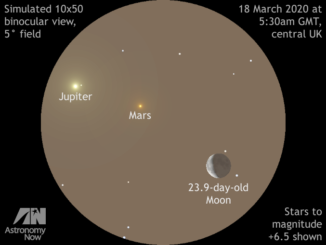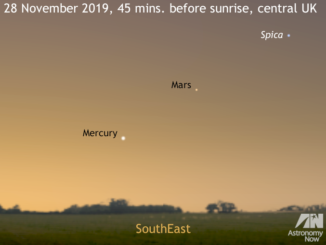

The separation of Mars and Uranus will be just ¼°, half the apparent size of the Full Moon. In your telescope, choose an eyepiece that gives you about 50x magnification (tip: our Scope Calc can help with eyepiece selection) so that you have a field of view close to one degree, if possible.
The close proximity of Mars makes finding Uranus easy since they will be in the same low-power telescopic field of view, but their difference in brightness will be 4.6 magnitudes, or 70 times.
Mars is currently on the far side of the Sun as seen from Earth, so it displays a gibbous phase. At magnitude +1.3, the Red Planet is 98% illuminated and displays a tiny 4.1-arcsecond disc since it’s 2.28 astronomical units (212 million miles; 341 million kilometres) away.
Contrast this with gas giant Uranus, the third largest planet in the Solar System, that lies a staggering 20.90 astronomical units (1,943 million miles; 3,127 million kilometres) from Earth tonight — nine times further away than Mars. Uranus will appear as a tiny 3.4-arcsecond disc shining at magnitude +5.9.
If you get the chance to see Mars and Uranus together through a telescope, consider the contrast not only in the brightness of these worlds as seen from Earth, but their physical characteristics: Mars is a rocky, terrestrial planet with a rarefied atmosphere half the size of Earth, while Uranus is four times larger than our planet and gaseous in composition. Clear skies!
Inside the magazine
You can find out more about Venus, Mars and Uranus in the March edition of Astronomy Now in addition to a full observing guide to the night sky.
Never miss an issue by subscribing to the UK’s biggest astronomy magazine. Also available for iPad/iPhone and Android devices.




